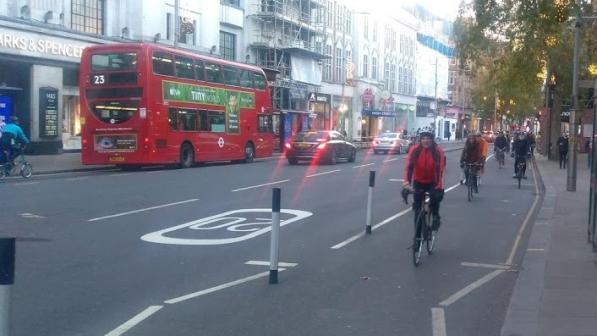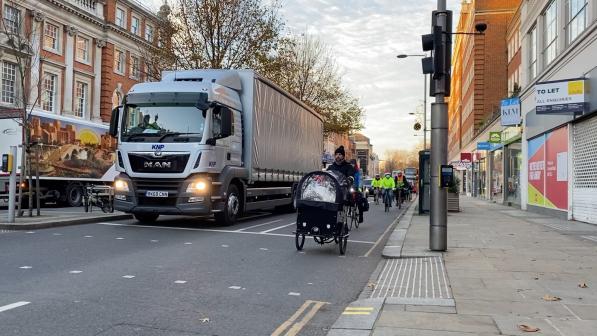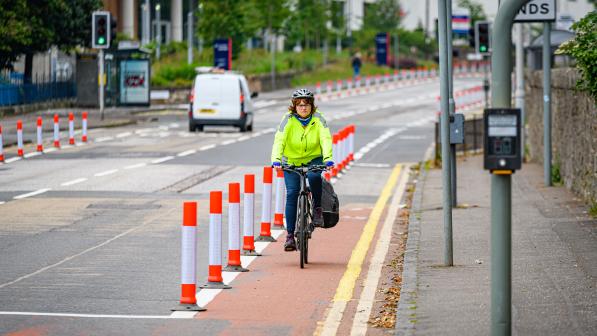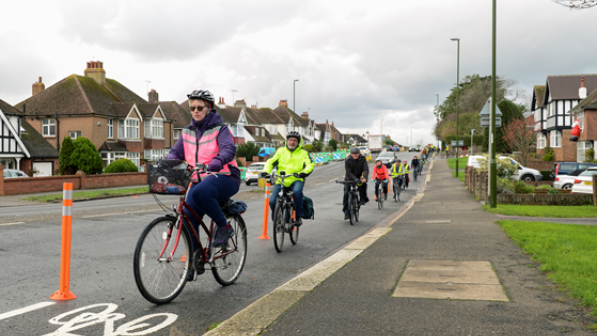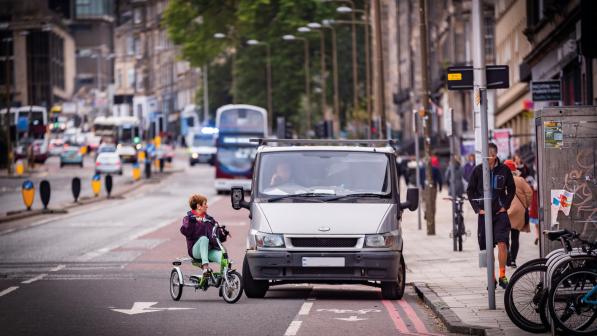News release: New cycle lanes no barrier to ambulances

- Freedom of Information investigation shows new government funded lanes not a problem for the blue light service
- Cycling UK encourages councils to keep building for “a safer, healthier and greener future”
Research by the cycling charity, Cycling UK has found widespread support from ambulance trusts for new cycle lanes introduced across the UK during the pandemic.
A Freedom of Information (FOI) investigation of all ambulance trusts in England, Scotland and Wales showed no trust was against the new cycle lanes, with a third of all trusts showing strong support for them because of their public health and road safety benefits.
Despite claims by some national newspapers that the new cycle lanes had been responsible for delaying or holding up ambulances on critical blue light emergencies, Cycling UK’s research found no evidence of any cases where this had occurred.
Duncan Dollimore, Cycling UK’s head of campaigns said:
“Cycling UK was concerned prominent members of the public, including politicians, and national media had been potentially misled to believe cycle lanes were preventing our paramedics from doing their jobs. Following our investigation and the positive responses we’ve received from the UK’s ambulance trusts, I am both pleased and relieved to slay these myths.
“These new cycle lanes which are helping thousands of people to travel safely, including key workers in our hospitals and paramedics, are no barrier to ambulances.”
Of the 12 trusts contacted, only North West Ambulance NHS Trust and the South East Coast Ambulance NHS Trust were unable to respond.
The investigation covered the period from March to November 2020, when following funding from national governments, councils were at their busiest building new temporary safer cycling and walking facilities to provide alternatives to public transport and make social distancing easier on the UK’s highstreets.
It sought to discover if any ambulance trust had not been consulted by local authorities when new cycling and walking measures were introduced. Trusts were also asked whether they had raised any concerns about schemes which might delay ambulance drivers or add to emergency response times.
Only one trust, East of England Ambulance Trust indicated there was any concern, identifying a barrier-controlled access to a pedestrian area in Cambridge.
Following further inquiry by Cycle magazine with Cambridgeshire County Council, it was discovered no lockable barriers were installed using the Department for Transport’s Emergency Active Travel Fund, and that the barrier in question likely referred to a barrier installed for counter-terror purposes in 2018.
As part of the investigation the trusts were also asked if they supported new cycling and walking schemes.
No trust indicated a lack of support for the new schemes, while four trusts expressed their support: South Central Ambulance Service, Yorkshire Ambulance Service, East Midlands Ambulance Service and London Ambulance Service.
In their response, the London Ambulance Service said:
“The Trust does not support withdrawing funding for active travel measures. However, the Trust recognises that changes to road layouts, traffic management schemes, and road closures all have the potential to impede our response to the most critically ill patients and could delay life-saving treatments or their conveyance to the nearest emergency department.
“For this reason, the Trust carries this risk on its Risk Register. The Trust also engages extensively with the boroughs and TfL [Transport for London] to ensure changes and traffic schemes (to reduce traffic congestion, improve air quality and road safety, and promote active travel) reflect our operational needs as an emergency service.”
Duncan Dollimore said:
“It’s hugely reassuring to see councils and ambulance trusts working together at this most difficult of times to ensure the safety and wellbeing not just of the paramedics’ patients but also of those who choose to walk and cycle.
“Survey after survey has shown the majority of the UK supports safer cycling and walking facilities, and Cycling UK would encourage councils to continue their good work and not let baseless allegations deter them from building a safer, healthier and greener future for us all.”
Surveys carried out for the Department for Transport, Cycling UK, #BikeIsBest and Greenpeace reveal that around 60% of the population agrees that more cycle lanes should be built.
Research from The Lancet Countdown on Health and Climate Change published this week said 5,771 lives could be saved from cuts to air pollution and 38,441 from more active travel, with 75% of people walking or cycling over the course of a week.
Notes to editors
- Cycling UK, the UK’s cycling charity, imagines a world where the streets are free of congestion and the air is clean to breathe, where parents encourage their children to cycle to school and everyone shares the exhilaration of being in the saddle. For more than 140 years, we’ve been making our streets safer, opening up new traffic free routes and inspiring more people to cycle more often. www.cyclinguk.org
- A copy of the report is available on the Cycling UK website see attachment above.
- The Lancet Countdown report is available at: https://www.lancetcountdown.org/2020-report/
Press contact information
For more information, please contact the national Cycling UK press office. Due to the restrictions caused by the coronavirus outbreak, currently the main press office number (01483 238 315) is not being monitored. If you would like to speak to a member of the press office during working hours please call 07786 320 713
